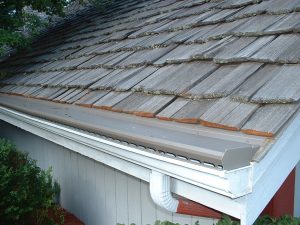 As the leaves change color and begin to fall and the temperatures drop, snow and below-freezing temperatures associated with the upcoming winter weather can’t be too far behind. For homeowners, fall is the time to make sure that their dwelling is prepared for preventing ice dams, as they can cause severe structural damage to a home.
As the leaves change color and begin to fall and the temperatures drop, snow and below-freezing temperatures associated with the upcoming winter weather can’t be too far behind. For homeowners, fall is the time to make sure that their dwelling is prepared for preventing ice dams, as they can cause severe structural damage to a home.
“The added weight of ice and snow from an ice dam can cause gutters to sag, pull away from the home, or even collapse,” said Christopher Wittmann, CR, exterior product specialist with Callen in Muskego, a full service and award-winning remodeling company. “Preventing ice dams from forming in the first place involves achieving the right balance of ventilation and insulation so the roof temperature matches the outdoor temperature of the eaves.”
Attic ventilation is paramount in terms of preventing ice dams. To understand why, you must familiarize yourself with the conditions needed for an ice dam to form. First, snow must be present on the roof. Second, the outside temperature of higher sections of the roof must be above freezing, while the roof edge must be below freezing. When these two conditions are present at the same time, they cause the snow towards the top of the roof that is above 32 degrees to melt and flow down to the areas of the roof that are below 32 degrees, where the water then freezes, creating an ice dam.
“Proper attic ventilation is designed to keep both the attic space and the roof cool by drawing in cold air from outside and flushing out warmer air from inside the attic,” said Wittmann. Proper attic venting combined with consecutive soffit vents will distribute cool air under the whole roof. The exhaust system is the other component of proper attic ventilation. All ductwork that is linked to the dryer, bathroom, and kitchen vents should be directed outside via the walls or roof. Under no circumstances should the exhaust ductwork be linked via the soffit. To ensure that a home’s attic ventilation system is functioning correctly and efficiently, it’s best to enlist the expertise of a qualified roofing professional.
It’s also important to close up any air leaks in the ceiling or attic to ensure warm air from the heated rooms don’t chase the cold air in the unheated attic. “You’ll want to be particularly mindful of the attic access door and the whole-house fan, as these can be prime sources of excessive heat loss,” said Wittmann. Weatherstrip caps can be used to effectively seal both of these areas.
Insulation goes hand in hand with proper attic ventilation. “Adding sufficient insulation in the attic is necessary to maintain a consistent temperature within the space,” said Wittmann. You’ll want to first examine the depth of the insulation in your attic. According to Energy Star, 16 to 20 inches of insulation is recommended for most attics. “If insulation measures less than this and ice dams are an annual occurrence, then you’ll want to add additional insulation to avoid future problems,” Wittmann said. “The best types of insulation are blown-in cellulose or even better, blown-in fiberglass, because they fit more snugly around rafters, joists, and other obstacles, limiting the number of empty spaces. Also, be sure to install baffles around older recessed lighting if they will be in close proximity to the insulation to remove any potential fire hazards. Newer recessed lighting that is made to be in contact with insulation (IC rated) is recommended.”
Although not a cure-all, removing the snow on your roof is a quick preventative fix, as snow is a fundamental component in the formation of an ice dam. A push broom or roof rake can be used to remove snow, however, you must take extra care not to damage any roofing materials. If you feel the need, seek out professional snow removal services.
Whenever a home’s roof is involved, it is always best to be proactive. Ice dams are especially problematic, as they can seriously compromise the gutter system and the roof itself. In fact, ice dams are one of the leading causes of snow related damage to roofs and shingles. So, removing snow from your roof in winter is a helpful short-term approach, but for a more long-term solution, you want to be sure the attic is properly ventilated fully insulated. “This will ensure that the correct temperatures are maintained inside and outside the home, preventing ice dams from forming,” said Wittmann.
Callen’s Muskego Design Center, S63 W13131 Janesville Rd., contains a variety of samples, including full kitchen and bath displays featuring Kohler fixtures and Starmark Cabinetry products, countertops, as well as Infinity from Marvin Fiberglass replacement windows. Callen’s Design Center in Brookfield, 19115 W. Capitol Dr., Suite 102, has a wide assortment of products on display, including Infinity® from Marvin fiberglass replacement windows, siding, doors, roofing, and Gutter Topper®.
Callen is a member of several home improvement and area associations, including NARI Milwaukee, the National Kitchen & Bath Association, the Metropolitan Builders Association Remodelers Council, Better Business Bureau, Angie’s List, the Muskego Area Chamber of Commerce, the Brookfield Chamber of Commerce, and the Hales Corners Chamber of Commerce.
For more information or to arrange an initial Design Center consultation, call Callen at 414-529-5509 or visit www.CallCallen.com.


